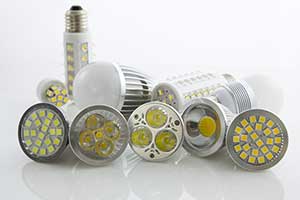Many Misconceptions Concerning LED Lighting
Part 3 of 3 articles covering the product options associated with LEDs
Successfully specifying and installing LED lighting is a complex process that presents managers with a host of potential misconceptions about the technology.
The existing lighting is adequate. Managers should not assume their facilities' current lighting is adequate. Lighting level codes might have changed, so the facility might require an upgrade to meet the new code. Lighting vendors can help in selecting the most efficient means to meet the new code, and lighting engineers, who often work with vendors, can assist with measuring current lighting levels, as well as understanding current code information.
Why not simply replace obsolete T12s with T8s? T8 fluorescents are still available in the United States and are much cheaper than LEDs, and the first cost of T8s is much lower than that of LEDs. But specifying T8 lamps presents two problems.
First, since it is now illegal to make or import T12s, how long will it be before T8s follow this same path to obsolescence? Second, while the first cost of T8s is lower, the total life cycle cost of LEDs is lower due to longer life and lower energy use. This relative energy inefficiency is the reason the federal government soon might ban T8s, just as it banned T12s.
Considering that a major upgrade will be very costly, it is important to look at the entire expected life of the system when making upgrade decisions. A manager could specify T8s, only to be forced to upgrade to LEDs in a few years anyway. In the meantime, the greater energy savings resulting from the LEDs would be lost.
All LED products result in the same savings. When searching for LED products, check the specifications for the watts per fixture. Some LEDs are more efficient than others. This energy difference adds up quickly.
Rebates cover all energy savers. When it comes to rebates, the power company does not provide rebates for all fixtures, even if the fixtures meet codes. Only those the power company has approved are acceptable, and the products must go through a pre-application procedure that a lighting engineer can assist in completing. This downloadable form asks for: the location of the installation; selected fixture make, model and specifications from the lighting manufacturer; old versus new power requirements; and energy savings.
If the pre-application is acceptable, the manager will receive notification of the rebate amount reserved. This approval does not mean the rebate is approved. It only means the fixture and the lighting use are approved. A post-installation application is made after the installation is complete. The power company representative inspects the installation to ensure the installation factors, such as number of fixtures, lighting levels, and wiring, meet power company requirements. Then the rebate receives final approval. The manager might receive the rebate after the installation invoice is due, so he must be prepared to allocate enough funds to pay the entire cost up front, including the rebate.
All warranties are the same. Always look for warranties in the manufacturers' specification sheets. In the case of LEDs, there is good news. Most LEDs have three- to five-year warranties. Further, they are tested to upwards of 100,000 hours, and these tests yield very interesting results. Under standard test conditions, LEDs often retain over 80 percent of their new lighting levels over that length of time, whereas other types of lighting degrade faster over a much shorter lifetime.
All similar LED fixtures cover the same area. Included in the specification sheet is the pattern of light distribution, which is very helpful in determining the number of fixtures required for the space. The pattern is for a specific installation height — say, 10 feet — and is displayed on a grid showing foot-candle levels at various horizontal distances directly below the fixture. It also displays the amount of dissipation that occurs as the distance increases to the outer limits of the fixture's effective lighting.
Motion sensors can always be used. Incorporating motion sensors can generate even more power savings. During times when there is no occupancy in the area, some or all of the lights can be switched off automatically when no motion is sensed for a set period of time. But managers need to be careful. Some codes might not permit motion sensors in some applications. For example, in garages, codes might prohibit using them for safety and security reasons.
Maintenance is the same for all LED installations. Some LED fixtures have open, adjustable louvers to allow users to customize the light pattern. But using these fixtures in a garage, for example, can enable bugs, dust and dirt to get in, creating a need for more frequent maintenance. Other fixtures are enclosed and sealed to prevent such problems, eliminating the need for interior cleaning. They do require workers to wipe the outside of the lens periodically.
LED is always the low-cost solution. We are in a transition from conventional incandescent lighting to other new technology. LED is still costly, and sometimes it is not the low-cost solution. Here are the cost results of a recent comparison of three specifications that deliver the same lighting level over 30,000 hours, which is the life of one LED bulb:
- incandescent 60 W — $187.82
- LED 7.5 W — $114.49
- CFL 13 W — 43.65.
The CFL is the winner from a cost standpoint, but it does contain mercury. If a CFL bulb cracks at the base, it releases mercury vapor. And facilities also must recycle CFLs according to local recycling methods instead of disposing of them in normal trash. In three to five years, according to estimates, this cost advantage will shift in favor of LEDs as the technology continues improving and as more manufacturers enter the LED mix.
Thomas Westerkamp is a maintenance and engineering management consultant and president of the work management division of Westerkamp Group LLC.
Related Topics:















